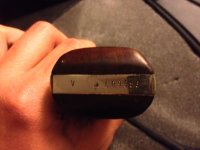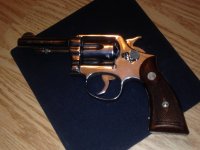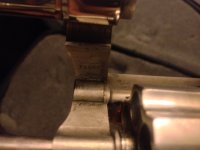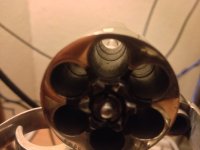I had one for awhile but eventually traded it in on a pre-Model 10.
Many people make a big deal out of the .38 Special conversion and not without some good reason.
The original .38 S&W chambers were on the order of about .0075" larger at the base than the .38 Special. The .38 S&W also used a .360" bullet, and, as you can see in pictures of chambers reamed to .38 Special, the .38 S&W chamber is still larger than the .38 Special near the former .38 S&W case mouth.
However, what people don't seem to connect is that the .45 Colt is a straight, parallel walled cartridge that is fired in a tapered chamber. This was done back in the BP era to ensure reliable extraction with BP fouling. However, despite the lack of need with smokeless powder, the old BP chamber specs were retained. Ironically enough the taper is .007" base to mouth, leaving the .45 Colt with the same degree of stretch as a .38 S&W chamber converted to .38 Special.
If you shoot the .45 Colt in a Ruger or Model 92, using higher Tier 2 or Tier 3 loads and full length resize them, the case life is much shorter than the average handgun cartridge due to increased working of the brass. The end result is spider cracks in the middle of the case, long before the neck cracks.
The resulting cracks however are not a safety issue as they occur above the point in the case where it is adhered to the chamber wall.
I found the .38 S&W>.38 Special chamber acted much the same way. I never had a case split or crack on the first few reloads but I'd start seeing them on the 4th or 5th reload. Like the .45 Colt, more pressure expands the brass more and increases the degree to which it is worked when resized, shortening case life.
In both cases, partial sizing works fine as they are straight, parallel wall cases, and you just need to size the case down to just past the base of the bullet. In the tapered chambers that you have on both cases, the rounds will chamber easily and be worked a lot less, extending brass life.
-----
In terms of the converted revolvers themselves, they were not technically "Victory Models", but rather .38/200 British Models. The early ones are not "US property" marked, while the later lend lease revolvers are marked like the Victory Models.
Regardless of markings, the pre-V and V prefixed .38 S&W chambered revolvers were all .38/200 chambered British Models. After S&W reached serial number 1,000,000 for their revolvers, they added a prefix, choosing "V" for victory, and the British Models just shared the same prefix and serial number series.
After December 1944 you'll see British and Victory Models with an "SV" prefix indicating a new hammer block. You'll also find un modified British Models with 4" 5" or 6" barrels as they were shipped in all three lengths.
----
The .38/200 cartridge is dimensionally identical to the .38 S&W, the difference lies in the use of a 200 grain bullet rather than a 140 grain bullet.
----
After WWII, a large number of these former British models were converted to .38 Special. The quality of the work varies a lot.
Early British Models were bright blued with S&W medallioned checkered grip, just like the commercial models. Later British models will have smooth grips and either sand blasted and blued finishes or a sandblasted black magic finish.
When nicely done, the conversion process involved plugging the lanyard hole filing the plug flush with the frame then polishing the revolver and blueing, creating a revolver that looked a lot like a Model 10 with a 4" 5" or 6" barrel, but with the expected shallowing out of the roll marks. Many of them were also nickel plated, but in both cases, the quality of the job varies and you'll often see a lack of polish behind the recoil shield, that reflects the original mid to late WWII level of finish on the sand blasted versions. Parker Hale converted a lot of them and you'll encounter British Models with Parker Hale ramp front sights.
You'll also still find military finished .38/200 British Models that were not refinished as well as British Models that were not refinished but were converted to .38 Special. At the time, one of the importers sold the stock British Models for $15.95, while the .38 Special converted British Models sold for $17.95, and surplus .38 Special Victory Models sold for $19.95.





